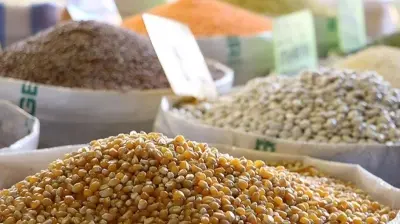Import And Export Of Grains And Legumes To The Middle East
Cereals and legumes are very important in the lives of Middle Eastern people and are considered as an important part of their diet. Some West Asian countries that are active in the production and trade of grains and legumes. Farmers in the Middle East and West Asia widely grow different types of grains and legumes. Per capita consumption of grains and legumes in West Asia may vary depending on the country and other factors.
The place of grains and legumes in the food of the people of the Middle East

Cereals and legumes are very important in the lives of Middle Eastern people and are considered as an important part of their diet. Cereals and legumes, especially rice, wheat, barley and chickpeas, are the main source of energy for people in the Middle East. These foods contain carbohydrates that act as fuel for the body and provide the necessary energy to perform daily activities. Legumes have a special place in the Middle East diet as cheap and rich sources of protein. The people of West Asia, especially in countries like Iran, Iraq, Turkey and Lebanon, use grains and legumes a lot in preparing their traditional foods.
Cereals and legumes have a lot of fiber, protein, vitamins and minerals. Consuming these foods can help to eat healthy and meet people's nutritional needs. Many countries in the Middle East have the ability to produce grains and legumes. These food resources can be used as a local base to meet people's food needs and reduce dependence on food imports.
The place of grains and legumes in the food of the people of the Middle East, Read More ...
Buying and selling grains and legumes in West Asia
Add your import and export orders to this list
Warning: Undefined variable $formTitle in /home/anbar/domains/anbar.asia/anbar/inc/html/desktop/orderform.php on line 10
Warning: Undefined variable $marketName in /home/anbar/domains/anbar.asia/anbar/inc/html/desktop/orderform.php on line 12
Warning: Undefined variable $location in /home/anbar/domains/anbar.asia/anbar/inc/html/desktop/orderform.php on line 12
If you want to trade in the , please join in Anbar Asia. Your order will be shown here, so the traders of contact you

The status of production and consumption of grains and legumes in West Asian countries

Some West Asian countries that are active in the production and trade of grains and legumes . The status of production and consumption of grains and legumes in West Asian countries may be different depending on the different conditions that exist in each country.
In the agricultural sector, the United Arab Emirates depends on the import of grains and legumes due to limited water resources and unfavorable weather conditions. But as an industrial and commercial country, the United Arab Emirates is one of the largest importers of grains and legumes in the region.
The status of production and consumption of grains and legumes in West Asian countries, Read More ...
Which of the grains and legumes do West Asian farmers grow?

Farmers in the Middle East and West Asia widely grow different types of grains and legumes . This region is suitable for the production of grains and legumes due to the weather conditions and suitable soil. Wheat is considered as one of the most important grains in this region. Farmers in the Middle East and West Asia, including Iran, Iraq, Turkey , and Syria, grow wheat extensively.
Due to the lack of water in the Middle East region, farmers use different methods and techniques to cultivate legumes and grains to optimize water consumption and increase water productivity in the cultivation process. Drip irrigation is an effective method for cultivation in low water areas. In this method, water is directly and precisely injected into the roots of the plants. This method reduces transpiration and evaporation from the leaves and significantly reduces water consumption.
Which of the grains and legumes do West Asian farmers grow?, Read More ...
Per capita consumption of grains and legumes in West Asia

Per capita consumption of grains and legumes in West Asia may vary depending on the country and other factors. It should be noted that these figures may change over time and vary depending on new conditions and various factors. Every country in the Middle East has its own culture and diet. Some countries may focus more on consumption of cereals such as wheat and barley, while others have a higher consumption of legumes such as lentils and chickpeas. This cultural and dietary diversity has a significant effect on the per capita consumption of grains and legumes.
In addition, other factors can play an important role in changing per capita consumption, such as demographic changes, the growth rate of settlements, changes in food patterns, changes in the industrialization and commercialization process of countries, as well as the effects of crises and wars in the region. Therefore, per capita consumption of grains and legumes in the Middle East varies and is influenced by cultural, economic, supply and political factors. Each country has its own characteristics and conditions that make the consumption of these products variable in this region.
Per capita consumption of grains and legumes in West Asia, Read More ...




